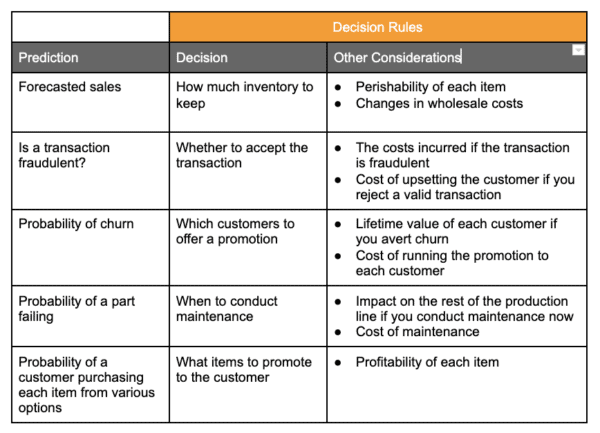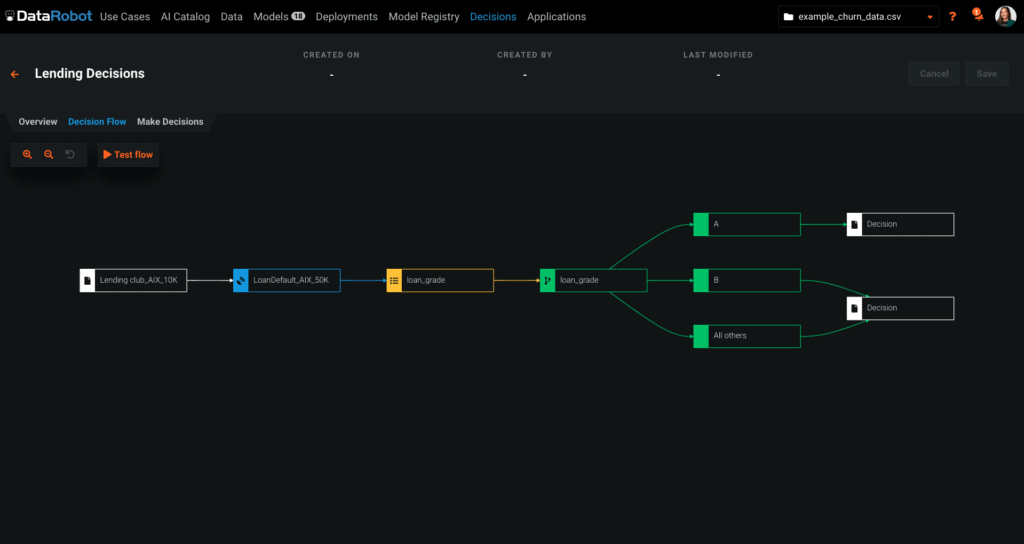
[ad_1]
It’s Time to Move Beyond Predictions
AI has long been associated with making predictions, but it’s your decisions rather than predictions that impact the world.
For example, a grocer might predict that they’ll sell 2,700 mangos at a given store between shipments. This information is powerful, but ultimately the grocer needs to decide how many mangos to order for that store, and the prediction doesn’t tell them exactly what to do.
Stocking exactly the 2,700 mangos will lead to empty shelves and disappointed customers if the forecast underestimates demand. So, demand planners carry “safety stock” beyond the predicted amount to keep customers happy.
But how much safety stock should they carry? That is the ultimate decision.
Organizations using AI most effectively put a lot of thought into decisions like these. So they create business or “decision rules” that act on the output of their predictive models to add business best practices and standardize decision-making across the organization. In our grocery example, a simple decision rule might be that you always carry 10% more than the forecasted sales.
At DataRobot, we have seen companies start with simple decision rules like these. Over time, they layer on more intelligence. For example, a second predictive model might forecast future changes in wholesale costs, so the grocer might make a smarter decision rule that appropriately stocks up before a price spike.
Decision rules aren’t specific to demand forecasting and inventory management. We see them used in machine learning use cases in every industry.
Here are some other use cases examples. For each decision, we have also listed any additional considerations impacting the decision rule.

Unfortunately, implementing decision rules has been difficult.
Some companies build models but never put them into production because they lack the necessary decision infrastructure. Other companies implement decision rules, but do it by writing their own Python, Java or SQL. This is labor-intensive, complex, and expensive to maintain—not to mention the important fact that non-technical stakeholders complain about the lack of transparency into how decisions are made.
Some companies use dedicated business rules engines, but many of these rules engines aren’t designed to work with machine learning.
We’ve seen many companies use Excel or Visual Basic to translate predictions into decisions, but they’re frequently disappointed that decision-making remains manual and time-consuming.
Ultimately, these organizations are frequently disappointed that decision-making remains manual, time-consuming, and locked up in code.
At DataRobot, we have realized businesses need something easier, more scalable, and more transparent. Decision Intelligence Flows, new release 7.2, addresses these goals directly.
Introducing DataRobot Decision Intelligence Flows
Decision Intelligence Flows allow you to quickly and visually create complex rules to assess your predictions and automate the decision-making process at scale.
There are three major benefits to Decision Intelligence Flows:
- It’s Easy to Create Really Complex Rules: You need your decision logic to be easy to create, understand, and update. Our decision flow editor is an intuitive GUI that lets you easily create rules by point and click, then see how data flows through a decision flowchart that embeds both your business knowledge and your AI models.

- Make Decisions With Speed and Scale: After creating a decision flow, you can apply it to datasets both large and small through our drag-and-drop interface, or you can deploy it to a REST endpoint. This enables you to make new decisions in real-time or as a batch process to make millions of decisions every day.
- Transparent and Trusted Decisions: See exactly which decision flow was used for any decision. The machine learning models that inform your decisions are tracked within DataRobot MLOps so that you can see how input data changes over time. Our interface is designed specifically for transparency to everyone from non-technical stakeholders to experienced data scientists.
Want to Learn More?
Decision Intelligence Flows are a new addition to DataRobot’s MLOps platform in release 7.2. You can build models with DataRobot AutoML or you can code them yourself (using tools like TensorFlow, Scikit-learn, XGBoost, PyTorch). Deploy them in the MLOps platform and define Decision Intelligence Flows to translate predictions into the bottom line results your business cares about.
Check out the demo on the Decision Intelligence Flows web page or request a live demo personalized just for you.
[ad_2]
Source link